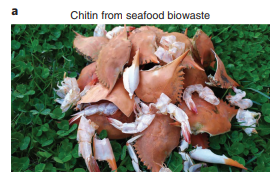News Story
Converting Biowaste into Hydroxide Exchange Membrane

Ion exchange membranes that selectively transport ions are critical for applications such as fuel cells, flow batteries, electrolyzers, and more. Compared to Nafion – a typical proton exchange membrane – hydroxide exchange membranes (HEMs), which are more compatible for use with platinum-free catalysts in alkaline electrolytes, are not well-established mainly due to the instability of HEMs in alkaline solution.
Recently, a group of researchers from the Universities of Maryland (UMD) and Delaware (UD) developed a new type of copper material, Cu2+-crosslinked chitosan (chitosan-Cu), which is derived from chitin – a fibrous material primarily found in the exoskeletons of arthropods, widely available as a biowaste. Due to its unique trigonal structure, chitosan-Cu was found to be a stable, high-performance HEM. Meiling Wu, a postdoctoral associate in the UMD Department of Materials Science and Engineering (MSE), served as first author on the study published April 18 in Nature Nanotechnology.
“Chitosan – a product extracted from the deacetylation of chitin – is the only basic polysaccharide that contains free amino groups, which in their cationic charged state can attract anions (e.g., OH−) for anion exchange applications, but with insufficient ion conductivity,” said Wu. “However, after combining this material with copper-ions, chitosan refreshes itself into a high-performing substance.”
The copper-ion coordination process with chitosan converts the twofold symmetric structure of the chitosan chains into a unique, threefold helical arrangement. The formation of the Cu2+-crosslinked chitosan chains, in which six chains are connected by Cu2+ to form a ~1 nm wide hexagonal nanochannel, chitosan-Cu achieves fast hydroxide transport, giving way to highconductivity – the robust binding in this case is crucial for structural stability.
“The features of chitosan-Cu make it an excellent ion exchange membrane for fuel cells, which we have demonstrated in a DMFC with a super-high power density,” said Liangbing Hu, MSE Professor at UMD and primary investigator on the study. “What’s more, this scalable method provides an abundant, eco-friendly and low-cost biopolymer to other HEMs currently on the market.”
For additional information:
Wu, M. et al (2022). “A high-performance hydroxide exchange membrane enabled by Cu2+-crosslinked chitosan,” Nature Nanotechnology. DOI: 10.1038/s41565-022-01112-5
Published April 18, 2022









